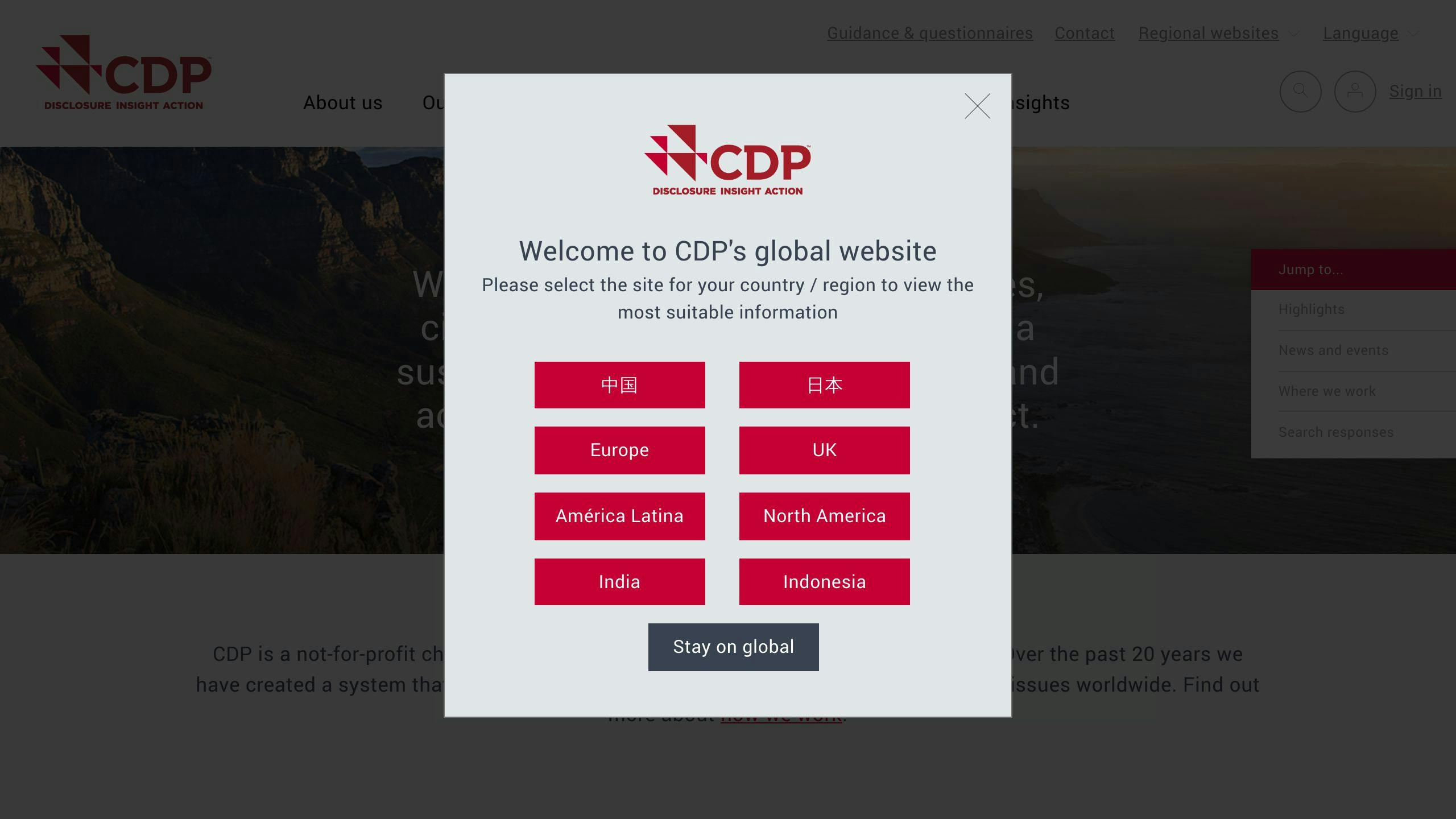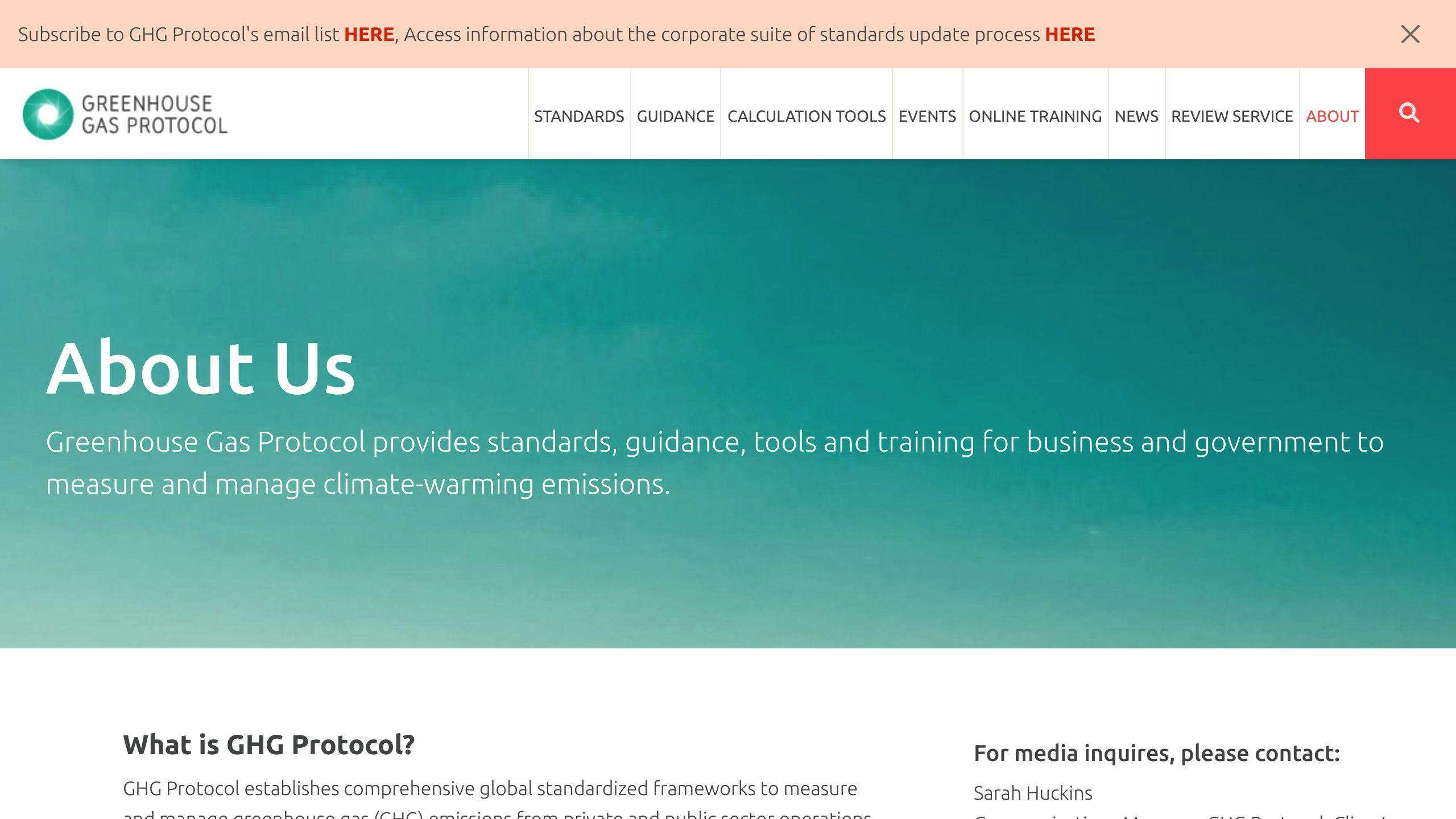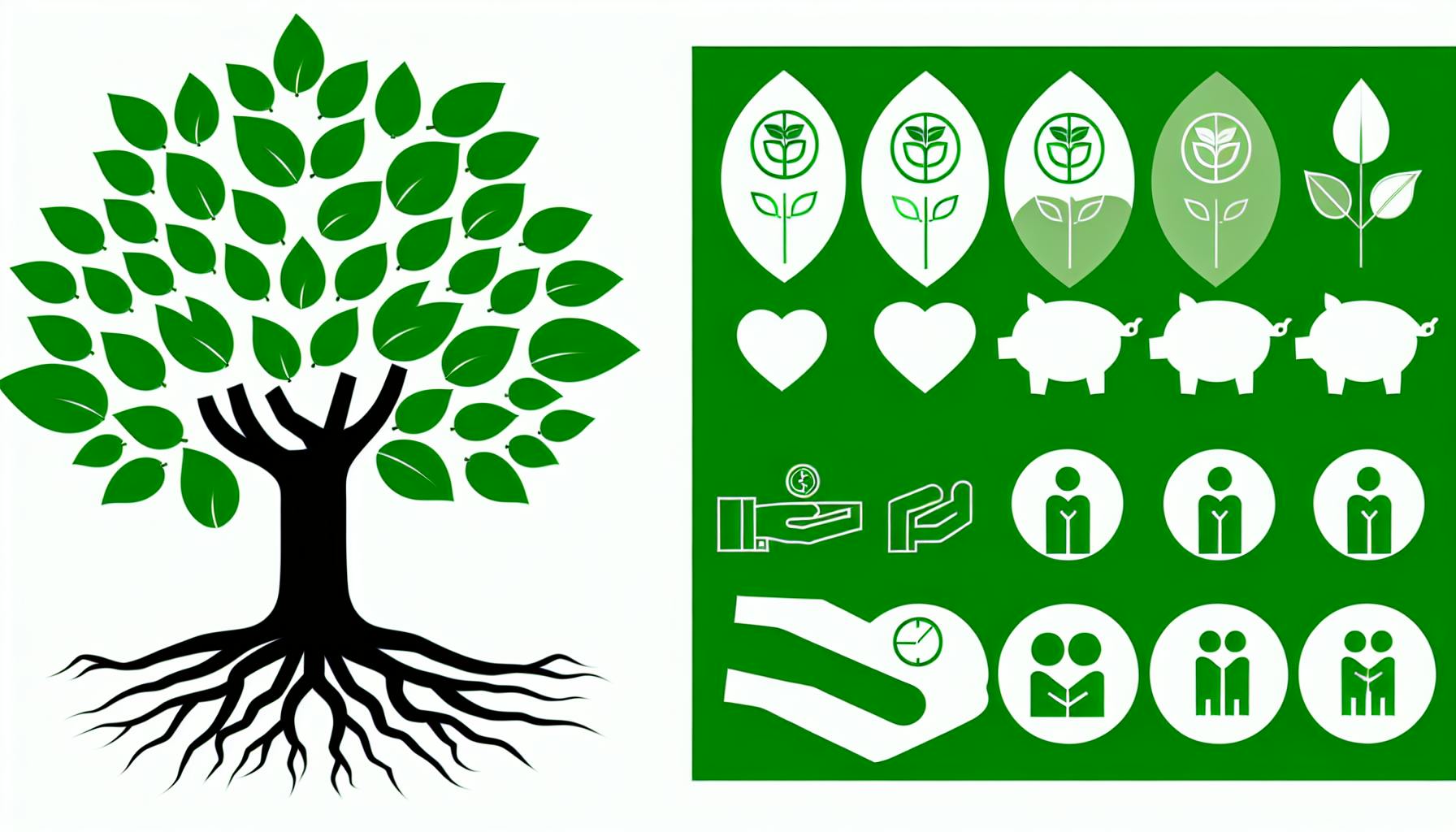Effective carbon reporting is crucial for small and medium-sized enterprises (SMEs) to reduce their environmental impact and contribute to a sustainable future. Here are the top 10 best practices:
-
Establish a Clear Carbon Reporting Strategy - Define your approach, follow transparency, accuracy, and completeness principles, and reap benefits like improved brand reputation and cost savings.
-
Choose a Relevant Reporting Framework - Adopt a structured framework like the CDP to streamline greenhouse gas accounting, set science-based targets, and engage stakeholders.
-
Gather Accurate and Reliable Data - Identify relevant data sources, determine boundaries, collect and record data, and validate/verify for accuracy.
-
Calculate Emissions Using Established Methodologies - Follow the Greenhouse Gas Protocol, choose appropriate emissions factors, and ensure accuracy through validation.
-
Identify Emissions Hotspots and Opportunities - Analyze data to pinpoint high-emission areas and explore reduction strategies like energy efficiency and supply chain engagement.
-
Set Science-Based Targets and Reduction Goals - Establish specific, measurable, and ambitious targets aligned with limiting global warming to 1.5°C.
-
Engage Stakeholders and Communicate Progress - Transparently share achievements and challenges, boost credibility with certifications, and use visual storytelling.
-
Ensure Data Quality and Assurance - Establish data management plans, use standardized methodologies, implement validation processes, and consider third-party verification.
-
Leverage Technology and Automation - Utilize carbon accounting software to automate data collection, calculation, and reporting for increased efficiency and accuracy.
-
Continuously Monitor and Improve - Regularly review and refine your strategy, data collection, emissions reduction goals, and stakeholder engagement.
By following these best practices, SMEs can effectively measure, report, and reduce their carbon emissions, contributing to a more sustainable business model and a better future for our planet.
1. Establish a Clear Carbon Reporting Strategy
To effectively measure, report, and reduce carbon emissions, SMEs need a clear carbon reporting strategy. This strategy helps businesses identify their carbon footprint, set realistic reduction targets, and communicate their progress to stakeholders.
Principles of Effective Sustainability Communication
When reporting carbon emissions, SMEs should follow these core principles:
| Principle | Description |
|---|---|
| Transparency | Disclose full methodologies, data sources, and key assumptions to ensure accuracy and trust. |
| Accuracy | Ensure measurements follow consistent, industry-accepted approaches for fair comparisons over time. |
| Completeness | Account for all relevant emission sources within the chosen inventory boundary to avoid omissions and misrepresentation. |
By investing time into robust carbon accounting and reporting, SMEs build a foundation for honest, meaningful sustainability communications.
Benefits of a Clear Carbon Reporting Strategy
A clear carbon reporting strategy offers several benefits, including:
- Improved brand reputation: Demonstrating a commitment to sustainability enhances your brand image and attracts environmentally conscious customers.
- Cost savings: Identifying operational inefficiencies through carbon accounting can lead to cost reductions and improved resource allocation.
- Competitive advantage: SMEs that report their carbon emissions and set reduction targets can differentiate themselves from competitors and attract new business opportunities.
By establishing a clear carbon reporting strategy, SMEs can take the first step towards a more sustainable and responsible business model, contributing to a better future for our planet.
2. Choose a Relevant Reporting Framework
When it comes to carbon reporting, SMEs need a structured approach to measuring, reporting, and reducing greenhouse gas (GHG) emissions. A reporting framework helps SMEs identify their carbon footprint, set realistic reduction targets, and communicate their progress to stakeholders.
CDP Reporting Framework for SMEs

The CDP (Carbon Disclosure Project) reporting framework is a popular choice for SMEs. It's a transformative tool designed to facilitate climate disclosure, setting science-based targets, and fostering sustainability among SMEs.
Key Features of the CDP Framework
The CDP framework offers several benefits for SMEs:
| Feature | Description |
|---|---|
| Streamlined GHG accounting | Aligns with GHG accounting practices, making it easier to measure and report emissions. |
| Science-based targets | Helps set targets aligned with the latest climate science, ensuring reduction efforts are meaningful and effective. |
| Stakeholder engagement | Provides a platform to engage with stakeholders, including investors, customers, and regulators, and demonstrate commitment to sustainability. |
By choosing a relevant reporting framework like the CDP framework, SMEs can ensure their carbon reporting is accurate, reliable, and effective in reducing their environmental impact.
3. Gather Accurate and Reliable Data
Gathering accurate and reliable data is crucial for carbon reporting in SMEs. This involves collecting relevant data on your company's greenhouse gas emissions, which can be complex and time-consuming. To ensure accuracy and reliability, follow a structured approach.
Identify Relevant Data Sources
Identify the relevant data sources within your organization, including:
- Energy bills and invoices
- Fuel consumption records
- Travel logs and mileage reports
- Waste management records
- Supply chain data
Determine Data Boundaries
Determine the boundaries of your data collection, considering:
| Boundary Type | Description |
|---|---|
| Operational Control | Include operations and facilities under your control. |
| Equity Share | Include joint ventures and partially owned entities proportional to your equity share. |
| Financial Control | Optionally include operations and facilities under your financial control. |
Collect and Record Data
Collect and record data from the identified sources within the determined boundaries. Ensure the data is accurate, complete, and consistent. Consider using carbon accounting software or tools to streamline the process.
Validate and Verify Data
Validate and verify the collected data to ensure accuracy and reliability. This may involve:
- Checking for errors and inconsistencies
- Conducting spot checks and audits
- Verifying data with third-party sources
By following these steps, you can ensure that your data is accurate, reliable, and suitable for carbon reporting. Regularly review and update your data collection process to maintain accuracy and reliability.
4. Calculate Emissions Using Established Methodologies
Calculating emissions is a critical step in carbon reporting for SMEs. To ensure accuracy and reliability, it's essential to use established methodologies that are widely accepted and respected.
GHG Protocol: The Global Standard

The Greenhouse Gas Protocol (GHG Protocol) is the most widely used international carbon accounting standard. It provides a comprehensive framework for quantifying and reporting greenhouse gas emissions.
Emissions Scopes
The GHG Protocol separates emissions into three scopes:
| Scope | Description |
|---|---|
| Scope 1 | Direct emissions from sources owned or controlled by the company, such as fuel combustion and manufacturing processes. |
| Scope 2 | Indirect emissions from purchased electricity, heat, or steam. |
| Scope 3 | Indirect emissions from the company's value chain, including supply chain, transportation, and employee commuting. |
Choosing the Right Emissions Factors
Emissions factors are used to convert activity data into emissions estimates. It's essential to choose emissions factors that are relevant to your company's operations and location.
Emissions Factor Sources
| Source | Description |
|---|---|
| IPCC | The Intergovernmental Panel on Climate Change (IPCC) provides emissions factors for various sectors and regions. |
| National emissions factors | Many countries provide national emissions factors for specific sectors and fuels. |
| Industry-specific emissions factors | Some industries, such as cement or steel, have developed their own emissions factors. |
Calculating Emissions
Once you have gathered activity data and chosen the right emissions factors, you can calculate your company's emissions. This involves multiplying the activity data by the corresponding emissions factor.
Ensuring Accuracy and Reliability
To ensure accuracy and reliability, it's essential to:
- Validate and verify data: Check for errors and inconsistencies in your data and emissions calculations.
- Use robust methodologies: Follow established methodologies, such as the GHG Protocol, to ensure consistency and accuracy.
- Document assumptions: Clearly document any assumptions made during the emissions calculation process.
By following these guidelines, SMEs can ensure that their emissions calculations are accurate, reliable, and consistent with international best practices.
5. Identify Emissions Hotspots and Opportunities
Identifying emissions hotspots and opportunities is a crucial step in carbon reporting for SMEs. This involves analyzing your company's emissions data to pinpoint areas with high emissions intensity and potential for reduction.
Emissions Hotspots
Emissions hotspots refer to areas within your company's operations or value chain where emissions are particularly high. These hotspots can be identified by analyzing emissions data across different scopes.
| Scope | Description |
|---|---|
| Scope 1 | Direct emissions from owned or controlled sources, like fuel combustion and manufacturing processes. |
| Scope 2 | Indirect emissions from purchased electricity, heat, or steam. |
| Scope 3 | Indirect emissions from the company's value chain, including supply chain, transportation, and employee commuting. |
Common emissions hotspots for SMEs include:
- Energy-intensive manufacturing processes
- Transportation and logistics
- Supply chain emissions from raw materials and components
- Employee commuting and business travel
Opportunities for Reduction
Once emissions hotspots are identified, SMEs can explore opportunities to reduce emissions and improve their carbon footprint. Some potential strategies include:
- Energy efficiency measures: Implementing energy-efficient technologies and practices to reduce energy consumption.
- Renewable energy sourcing: Transitioning to renewable energy sources, like wind or solar power, to reduce dependence on fossil fuels.
- Supply chain engagement: Working with suppliers to reduce their emissions and improve their sustainability practices.
- Transportation optimization: Implementing more efficient transportation routes and modes to reduce fuel consumption and emissions.
By identifying emissions hotspots and opportunities for reduction, SMEs can develop targeted strategies to reduce their carbon footprint and improve their overall sustainability performance.
Remember, accurate emissions data is essential for identifying hotspots and opportunities. Ensure that your emissions calculations are accurate, reliable, and consistent with international best practices.
sbb-itb-c2a0016
6. Set Science-Based Targets and Reduction Goals
Setting science-based targets and reduction goals is a crucial step in carbon reporting for SMEs. This involves establishing a clear roadmap for reducing greenhouse gas emissions and achieving net-zero status.
What are Science-Based Targets?
Science-based targets are specific, measurable, and ambitious goals that align with the level of decarbonization required to limit global warming to 1.5°C above pre-industrial levels.
Benefits of Setting Science-Based Targets
Setting science-based targets can bring numerous benefits to SMEs, including:
- Enhanced credibility: Demonstrate commitment to reducing carbon footprint and contributing to a sustainable future.
- Cost savings: Reduce energy consumption and transition to renewable energy sources to save costs.
- Access to funding and opportunities: Eligibility for funding and opportunities that are not available to those that do not set science-based targets.
How to Set Science-Based Targets
To set science-based targets, SMEs should follow these steps:
| Step | Description |
|---|---|
| 1 | Conduct a greenhouse gas inventory: Calculate your company's greenhouse gas emissions using a recognized methodology such as the Greenhouse Gas Protocol. |
| 2 | Determine your target: Based on your inventory, determine your target for reducing greenhouse gas emissions. This should be a specific, measurable, and achievable goal. |
| 3 | Choose a target validation route: SMEs can choose to validate their targets through the Science-Based Targets initiative (SBTi) or through a third-party verification process. |
| 4 | Develop a reduction strategy: Create a plan for achieving your target, including specific actions and milestones. |
By setting science-based targets and reduction goals, SMEs can take a critical step towards reducing their carbon footprint and contributing to a sustainable future.
7. Engage Stakeholders and Communicate Progress
Effective stakeholder engagement and communication are crucial for SMEs to demonstrate their commitment to carbon reporting and sustainability. This involves transparently sharing progress, achievements, and challenges with stakeholders, including employees, customers, investors, and regulatory bodies.
Principles of Effective Communication
To engage stakeholders and communicate progress, SMEs should adhere to core principles of:
| Principle | Description |
|---|---|
| Transparency | Disclose full methodologies, data sources, and key assumptions to build trust and credibility. |
| Accuracy | Ensure measurements follow consistent, industry-accepted approaches for fair comparisons over time. |
| Completeness | Account for all relevant emission sources within your chosen inventory boundary to provide a comprehensive picture. |
Boosting Credibility with Certifications
Independent validation from reputable third parties can further enhance the credibility of self-reported climate achievements. Consider displaying certifications like B Corp, CarbonNeutral®, or ISO 14001 prominently across websites and sustainability reports to signal to stakeholders that sustainability credentials have undergone external scrutiny.
Visual Storytelling: Making Carbon Data Engaging
Transforming complex emissions data into intuitive charts and graphs makes for more engaging sustainability communications. Use interactive charts, clean visual design, and relatable comparisons to draw attention to key metrics and trends, allowing stakeholders to engage deeply with sustainability initiatives.
By adopting these strategies, SMEs can foster trust, encourage stakeholder engagement, and demonstrate their commitment to sustainability and carbon reporting.
8. Ensure Data Quality and Assurance
Accurate and reliable carbon data is crucial for SMEs to make informed decisions, track progress, and demonstrate transparency. Ensuring data quality and assurance helps build trust with stakeholders and supports compliance with mandatory GHG disclosure regulations.
Data Quality Challenges
SMEs often face difficulties in maintaining data quality due to:
- Incomplete or inconsistent data collection
- Manual data entry errors
- Lack of standardization in data sources and methodologies
- Insufficient resources for data validation and verification
Best Practices for Data Quality and Assurance
To overcome these challenges, SMEs can adopt the following best practices:
| Best Practice | Description |
|---|---|
| Establish a clear data management plan | Define data collection procedures, assign responsibilities, and set data quality standards. |
| Use standardized data sources and methodologies | Ensure consistency in data collection and calculation methods to minimize errors and inconsistencies. |
| Implement data validation and verification processes | Regularly review and validate data to detect errors, inconsistencies, and gaps. |
| Leverage technology and automation | Utilize carbon accounting software and tools to streamline data collection, calculation, and reporting, reducing the risk of human error. |
| Engage third-party verification | Consider independent verification of carbon data to provide assurance and enhance credibility. |
By implementing these best practices, SMEs can ensure the accuracy, completeness, and reliability of their carbon data, ultimately supporting informed decision-making and stakeholder trust.
9. Leverage Technology and Automation
Carbon reporting for SMEs can be simplified by leveraging technology and automation. Manual processes can be time-consuming, prone to errors, and may not provide the level of accuracy and detail required for informed decision-making.
Automation Benefits
Automation can help SMEs:
- Reduce errors and inconsistencies
- Increase the speed and efficiency of data collection and reporting
- Improve data accuracy and reliability
- Enhance transparency and stakeholder trust
- Support compliance with mandatory GHG disclosure regulations
- Identify opportunities for cost savings and emissions reduction
Choosing the Right Carbon Accounting Software
When selecting a carbon accounting software, SMEs should consider the following factors:
| Feature | Description |
|---|---|
| Automation capabilities | Can the software automate data collection, calculation, and reporting? |
| Data integration | Can the software integrate with existing systems and data sources? |
| Customization | Can the software be tailored to meet specific business needs and reporting requirements? |
| Scalability | Can the software grow with the business and adapt to changing reporting requirements? |
| User interface | Is the software user-friendly and accessible to non-technical users? |
By leveraging technology and automation, SMEs can simplify their carbon reporting processes, reduce costs, and focus on making informed decisions to reduce their environmental impact.
10. Continuously Monitor and Improve
Regularly reviewing and refining your carbon reporting process is crucial for SMEs to ensure accuracy, transparency, and effectiveness in their sustainability efforts.
Review and Refine Your Strategy
Regularly review your carbon reporting strategy to ensure it aligns with your business goals and stakeholder expectations. Make changes as needed to address emerging challenges and opportunities.
Enhance Data Collection and Analysis
Continuously monitor and improve your data collection processes to ensure accuracy and consistency. Leverage technology and automation to streamline data collection, analysis, and reporting.
Refine Emissions Reduction Goals and Targets
Regularly review and refine your emissions reduction goals and targets to ensure they remain ambitious and achievable. Set science-based targets and develop actionable plans to achieve them.
Engage Stakeholders and Communicate Progress
Continuously engage with stakeholders to communicate progress towards your emissions reduction goals. Share successes, challenges, and lessons learned to build trust and transparency.
By continuously monitoring and improving your carbon reporting process, SMEs can ensure accuracy, transparency, and effectiveness in their sustainability efforts, ultimately driving business value and contributing to a low-carbon economy.
Key Takeaways
| Area | Action |
|---|---|
| Strategy | Regularly review and refine your carbon reporting strategy |
| Data Collection | Continuously monitor and improve data collection processes |
| Emissions Reduction | Refine emissions reduction goals and targets |
| Stakeholder Engagement | Engage stakeholders and communicate progress |
By following these key takeaways, SMEs can ensure a robust and effective carbon reporting process that drives business value and contributes to a low-carbon economy.
Conclusion
By following these top 10 carbon reporting best practices, small and medium-sized enterprises (SMEs) can play a vital role in reducing their environmental impact and contributing to a sustainable future.
Benefits of Effective Carbon Reporting
Effective carbon reporting can bring numerous benefits to SMEs, including:
| Benefit | Description |
|---|---|
| Improved environmental performance | Identify areas for reduction and implement strategies to minimize carbon footprint |
| Enhanced stakeholder trust and reputation | Demonstrate transparency and accountability in carbon reporting |
| Business resilience | Identify opportunities for cost savings, improve operational efficiency, and mitigate climate-related risks |
Take Action Today
In today's eco-conscious world, SMEs have a critical role to play in reducing global greenhouse gas emissions. By prioritizing carbon reporting and implementing these best practices, SMEs can make a significant impact and contribute to a low-carbon economy.
Remember, carbon reporting is not just a regulatory requirement; it's a business imperative. By taking proactive steps to measure, report, and reduce their carbon emissions, SMEs can reap numerous benefits and contribute to a more sustainable future.
Start your carbon reporting journey today and join the movement towards a more sustainable tomorrow!


